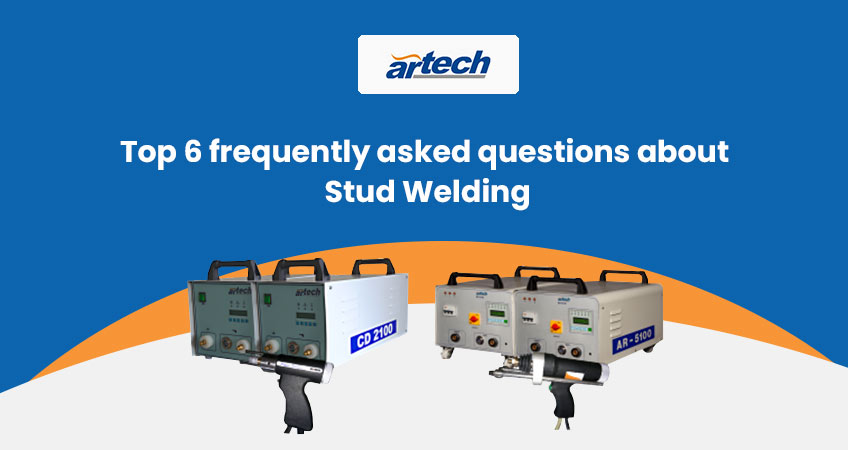Stud Welding is one of the most popular welding methods known for its visually appealing aesthetics, accuracy, reliability, cost-efficiency, and speed. It can be used for welding ferrous and non-ferrous studs of smaller diameter on light gauge material. In this blog, we have answered the top frequently asked questions (FAQs) about Stud Welding. These answers will surely help you understand Stud Welding better and use stud welding machines in your industrial manufacturing processes efficiently.
Top 6 frequently asked questions (FAQs) about Stud Welding
-
What is Stud Welding?
Stud welding is a process that is used to join metal surfaces. In this process, the welded studs are subjected to high pressure as they are put into contact with one another. It is used for joining metal studs to a parent metal workpiece by heating both parts of metal with an electric arc. One can use a stud welding machine to join two or more pieces of metal together for various purposes.
-
What is the process of Stud Welding?
The process of stud welding occurs at the molten point of the metal. A stud welder has electric cables, which pass an electric current between two electrodes to produce an electric arc. The metal is heated with an arc. It generates enough heat to bring both metals to the melting point, and then pressure is applied to make a strong weld bond.
-
What are the different types of Stud Welding?
There are two major types of stud welding- Capacitor Discharge (CD) Welding and Drawn Arc Welding.
-
How long is the Stud Welding weld cycle?
The weld cycles in CD welding are less than 10 milliseconds and it also works under low temperatures. The weld cycles in Drawn arc stud welding can range from 5 msec to 1.5 sec. Since this method of welding is used for higher diameter studs, the weld time is more than the CD welding. It can weld studs from diameter 3mm to 25mm in such a short time.
-
Where is the stud welding machine used?
Stud welding is a fast and economical welding method for welding studs of a wide range of diameters and shapes on the parent metal. It is used for fixing studs onto parent metal without forming holes. The fact that it eliminates the operations such as drilling and tapping, makes it one of the popular welding methods with a wide range of applications. It is used in construction, automotive, shipbuilding, and other industries to name a few. In the construction industry, stud welds are often used as an alternative for hole punching or spot welding from one surface to another. In the automotive industry stud welds are often used as a support for two pieces of metal that need to be joined together permanently. In shipbuilding stud welds are often used to connect plates and other large surfaces that would normally have to be riveted or bolted together into one piece.
Applications of Capacitor Discharge Stud Welding
Elevator control panels, Sheet Metalwork, electrical control panels, switchboard cabinets, communications engineering, vending machines, windows, Stainless Steel Cookware, Insulation Fixing, Stainless Steel Kitchenware, Electrostatic Precipitators, laboratory and medical equipment, food industry, household appliances, glass constructions, insulation technology, industrial kitchens, etc.
Applications of Drawn Arc Stud Welding
steel construction, mechanical engineering, shipbuilding, structural and civil engineering, power plants and combustion systems, boiler and plant equipment, insulation and windows, buildings, transformer tanks, metal structures, heat exchangers, automobile, heavy fabrication, shear connector welding, PEB – pre-engineered buildings, rail overbridge (ROB), etc.
-
How to select between CD Welding and DA Welding?
Choosing between CD welding and DA welding is easy based on your welding requirements.
Use Capacitor Discharge Welding when:
- You require clean welds
- The base material is thin
- The diameter is small. CD welding can weld up to 08mm
- Need to maintain excellent aesthetics
- Need to avoid any marking on the reverse side of the weld area
- Only for studs with projection (pip)
Use Drawn Arc Welding when:
- You require high weld strength
- Parent material is slightly oily or scaly
- The diameter is big; 03mm to 25mm.
- For structural applications
- For drawn arc studs and short cycle studs
In The End Stud Welding has always been an integral aspect in most manufacturing industries. We hope these answers have cleared some major doubts about the features, benefits, and types of Stud Welding. Artech Welders has long-standing expertise of 25+ years in Capacitor Discharge Welding Technology. So far, we have partnered with hundreds of companies and helped them adopt better welding, efficiently. Our Stud Welding Machines are one of the highly in-demand solutions. From design, customization to delivery and beyond, Artech has proven capabilities to serve the needs of our valued customers. What are you waiting for? Switch to Stud welding with highly cost-efficient welding machines by Artech Welders. Get in touch with our team to request a quote!

